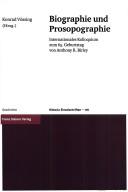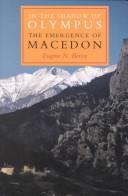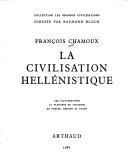Book
ISBN: 2356681604 Year: 2022 Publisher: Lyon : MOM Éditions,
Abstract | Keywords | Export | Availability | Bookmark
 Loading...
Loading...Choose an application
- Reference Manager
- EndNote
- RefWorks (Direct export to RefWorks)
Le second volume de cet ouvrage se donne pour but de présenter au lecteur l’ensemble des très nombreux documents sur lesquels s’est basée cette réflexion historique. Il ne prétend point à l’exhaustivité mais cherche à fournir de la façon la plus aisée possible, c’est-à-dire communauté par communauté, toutes les données épigraphiques et numismatiques, très dispersées au départ, que l’auteur a pu rassembler. Une brève présentation au début de chaque corpus permettra de bien saisir le système de classification de ces textes et monnaies. The second volume of this book intends to present to the reader all the very many documents on which this historical reflection was based. It does not claim to be exhaustive but seeks to provide in the easiest way possible, that is, community by community, all the epigraphic and numismatic data, very scattered at the outset, that the author was able to gather. A brief presentation at the beginning of each corpus will help to understand the classification system of these texts and coins.
Classics --- History --- Phrygie --- Asie Mineure --- époque achéménide --- époque hellénistique --- époque impériale romaine --- armée perse --- armées hellénistiques --- armée romaine --- poliadisation --- contrôle territorial --- maintien de l’ordre --- échanges culturels et religieux --- Phrygia --- Asia Minor --- Achaemenid period --- Hellenistic period --- Roman imperial period --- Persian army --- Hellenistic armies --- Roman army --- poliadization --- territorial control --- policing --- cultural and religious exchanges
Book
ISBN: 0520967917 9780520967915 9780520295001 Year: 2017 Publisher: Oakland, California
Abstract | Keywords | Export | Availability | Bookmark
 Loading...
Loading...Choose an application
- Reference Manager
- EndNote
- RefWorks (Direct export to RefWorks)
Seers featured prominently in ancient Greek culture, but they rarely appear in archaic and classical colonial discourse. Margaret Foster exposes the ideological motivations behind this discrepancy and reveals how colonial discourse privileged the city's founder and his dependence on Delphi, the colonial oracle par excellence, at the expense of the independent seer. Investigating a sequence of literary texts, Foster explores the tactics the Greeks devised both to leverage and suppress the extraordinary cultural capital of seers. The first cultural history of the seer, The Seer and the City illuminates the contests between religious and political powers in archaic and classical Greece.
Prophets --- Oracles, Greek. --- Religion and politics --- History. --- Hero --- Greece --- Colonies. --- ancient greece. --- ancient greek politics. --- ancient world. --- antiquity. --- archaic greece. --- archaic. --- classical greece. --- classical world. --- classical. --- colonial discourse. --- colonial. --- colonialism. --- culture. --- delphi. --- divination. --- greek culture. --- greek politics. --- hellenistic period. --- ideological. --- ideology. --- literary analysis. --- literary texts. --- oracle. --- politics. --- religion. --- religious studies. --- seercraft. --- seers.

ISBN: 3515085386 9783515085380 Year: 2005 Volume: 178. Publisher: Stuttgart: Steiner,
Abstract | Keywords | Export | Availability | Bookmark
 Loading...
Loading...Choose an application
- Reference Manager
- EndNote
- RefWorks (Direct export to RefWorks)
Biography --- Prosopography --- History, Ancient --- Biographies --- Prosopographie --- Histoire ancienne --- Congresses. --- Congrès --- Birley, Anthony Richard. --- 87 --- 937/938 --- 938.08 --- Klassieke literatuur --- Geschiedenis van de Klassieke Oudheid --- History Ancient world Greece Hellenistic period (323-146 b.C.) --- 937/938 Geschiedenis van de Klassieke Oudheid --- 87 Klassieke literatuur --- Congrès --- Prosopography - Rome - Congresses. --- Prosopography - Greece - Congresses. --- Antike. --- Biografieën. --- Biographie. --- Biography. --- History, Ancient. --- Inscripties. --- Klassieke oudheid. --- Prosopografieën. --- Prosopographie. --- Prosopography. --- Birley, Anthony Richard, --- Birley, Anthony, --- To 500. --- Düsseldorf (2002). --- Griechenland (Altertum). --- Römisches Reich.
Book
ISBN: 9782356130365 2356130365 235613283X Year: 2010 Publisher: Paris : Pessac : Diffusion de Boccard Ausonius,
Abstract | Keywords | Export | Availability | Bookmark
 Loading...
Loading...Choose an application
- Reference Manager
- EndNote
- RefWorks (Direct export to RefWorks)
Le présent volume procède d'un colloque organisé à Oxford à l'été 2006. Rassemblant linguistes, archéologues, épigraphistes, numismates et historiens, il fut l'occasion d'échanger des idées sur une période de transition fondamentale dans l'histoire de la Carie : le ive siècle et les deux siècles qui suivirent la conquête d'Alexandre. Cette période fut en effet d'abord marquée par la présence et la visibilité des satrapes, mais aussi ensuite par une intense activité civique et une conscience politique accrue des communautés cariennes. La symbiose entre les îles du Dodécanèse, en particulier Rhodes et Cos, et le littoral carien constitue un autre thème important. Plusieurs communications se rattachent enfin à une orientation de recherche sur les cultures anatoliennes qui est aujourd'hui en plein essor, celle de l'étude des interactions culturelles entre Grecs et Anatoliens depuis la fin de l'âge du Bronze et le début de l'âge du Fer, dont on perçoit encore les échos aux époques plus récentes. The conference on which the present volume is based took place in Oxford in the summer of 2006. It brought together linguists, archaologists, epigraphists, numismatists and historians and allowed them to exchange ideas about a period of major transition in Karian history: the fourth century and the two centuries after Alexander. This was first a period of great starapal visibility and presence, but then alsol of intense civic engagement and increased political awareness among Karian communities. The symbiotic relationship between the islands of the Dodekanese, in particular Rhodes and Kos, and the coastal regions of Karia forms another major theme. Finally, a number of papers pick up on a major recent trend in the study of Anatolian culture, namely the investigation of cross-cultural Greeak-Anatolian interactions in the Late Bronze and Early Iron Ages and their echoes in later periods.
Excavations (Archaeology) --- Carian language --- Cities and towns, Ancient --- Fouilles (Archéologie) --- Carien (Langue) --- Villes antiques --- Hecatomnus, --- Caria --- Greece --- Turkey --- Carie (Région ancienne) --- Grèce --- Turquie --- Relations --- Antiquities --- Antiquités --- Carians --- Dodekanesos (Greece) --- Language --- Conferences - Meetings --- Fouilles (Archéologie) --- Carie (Région ancienne) --- Grèce --- Antiquités --- Carie --- Karya --- Antiquities. --- History. --- Language. --- Classical Greek studies --- Classics --- History --- Antiquité grecque --- période hellénistique --- satrapie --- culture anatolienne --- Hellenistic period --- Antiquity --- military campaign --- Hellenistic civilization --- Carie (Turquie ) --- Antiquité
Book
ISBN: 9781501739552 1501739557 1501739565 1501739573 9781501739576 9781501739569 Year: 2019 Publisher: Ithaca [New York]: Cornell university press,
Abstract | Keywords | Export | Availability | Bookmark
 Loading...
Loading...Choose an application
- Reference Manager
- EndNote
- RefWorks (Direct export to RefWorks)
"First-person poetry is a familiar genre in Latin literature. Building on the Greek poetic tradition of performed poetry, Latin poets such as Propertius, Catullus, Horace, and Ovid positioned their speakers both as participants in the poem's narrative and as narrators standing outside the poem and shaping its discourse. This book offers a model for understanding the ubiquitous use of a first-person voice in Latin poetry, taking on several of the central debates in the field of Latin literary studies-- including the inheritance of the Greek tradition, the shift from oral performance to written collections, and the status of the poetic "I-voice"--through close readings of Catullus, Propertius, Horace, and (in the epilogue) Ovid. Moving beyond debates about how closely the textual speaker replicates the historical author, McCarthy analyzes poetic structure, showing how the poet draws the reader in by narrating scenes of address from which the reader is, paradoxically excluded, as if leaning in to listen to an overheard conversation"--
First person narrative. --- Latin poetry --- Point of view (Literature). --- Self in literature. --- History and criticism --- Theory, etc. --- Horace --- Horace. --- Catullus, Gaius Valerius --- Catullus, Gaius Valerius. --- Propertius, Sextus --- Propertius, Sextus. --- Criticism and interpretation. --- First person narrative --- Point of view (Literature) --- Self in literature --- Criticism and interpretation --- Latin poetry - History and criticism - Theory, etc. --- Horace - Criticism and interpretation --- Catullus, Gaius Valerius - Criticism and interpretation --- Propertius, Sextus - Criticism and interpretation --- poetic address, lyric, Hellenistic period, Roman period, Latin poetry.
Book
ISBN: 9782356681676 2356681671 2356680756 Year: 2021 Publisher: Lyon : MOM Éditions,
Abstract | Keywords | Export | Availability | Bookmark
 Loading...
Loading...Choose an application
- Reference Manager
- EndNote
- RefWorks (Direct export to RefWorks)
La mission archéologique syro-française de Qinnasrin a mené ses travaux de 2008 à 2010 sur le site d'al-'Iss (Syrie du Nord, région d'Alep), dans l'ensemble du bourg et dans ses environs immédiats, grâce aux financements de la Commission des fouilles du ministère de l'Europe et des Affaires étrangères, de la Fondation Max van Berchem, du CNRS et de la Direction générale des Antiquités et Musées de Syrie. Attestée depuis la fin du IIIe millénaire avant notre ère, Qinnasrin est un nœud routier et militaire important, qui domine une plaine fertile, aux confins de la steppe et des zones d'agriculture irriguée. Renommée Chalcis par les Grecs, elle est, à l'époque romaine, le siège d'une royauté et frappe monnaie. Elle joue un rôle essentiel dans le système de fortification de la Syrie du Nord mis en place par Justinien face aux Perses, puis lors de la conquête de la Syrie du Nord par les armées de l'islam. Étroitement liée à Alep, elle décline, à son profit, à partir du milieu du xe siècle et tombe dans l'oubli vers le XIVe siècle. Cet ouvrage dresse un état des lieux et une synthèse des sources textuelles et archéologiques. Il présente la documentation constituée par les prospections pédestre et géophysique, les premières fouilles archéologiques jamais menées sur le site, l'inventaire des blocs architecturaux et la collecte de matériel. Plusieurs découvertes permettent de rendre compte de l'importance acquise par la ville, tant aux périodes les plus anciennes qu'aux époques grecque, romaine ou islamique. Pour la première fois, un scénario de l'évolution morphologique de la ville et de ses transformations est proposé. Ce second volume de la série consacrée à Qinnasrin livre un portrait inédit d'un site remarquable et largement méconnu.
Fouilles archéologiques --- Chalcis ad Belum (ville ancienne) --- Excavations (Archeology) --- Architecture, Ancient --- Syria --- Antiquities --- Archaeology --- archéologie --- épigraphie --- morphologie urbaine --- Syrie du Nord --- âge du Bronze --- période hellénistique --- Empire romain --- Antiquité tardive --- période omeyyade --- période abbasside --- Moyen Âge --- églises d’Orient --- conquête musulmane --- fortification --- céramique --- sigillée --- archaeology --- epigraphy --- urban morphology --- Northern Syria --- Bronze Age --- hellenistic period --- roman empire --- Late Antiquity --- umayyad period --- abbasid period --- Middle Age --- oriental churches --- muslim conquest --- pottery --- sigillata --- Fouilles archéologiques --- Antiquité tardive. --- Qinnasrīn (Extinct city) --- Antiquities.
Book
ISBN: 9780520253360 0520253361 0520290844 9786612463204 1282463209 0520943635 9780520943636 9781282463202 6612463201 Year: 2010 Publisher: Berkeley : University of California Press,
Abstract | Keywords | Export | Availability | Bookmark
 Loading...
Loading...Choose an application
- Reference Manager
- EndNote
- RefWorks (Direct export to RefWorks)
This landmark contribution to ongoing debates about perceptions of the Jews in antiquity examines the attitudes of Greek writers of the Hellenistic period toward the Jewish people. Among the leading Greek intellectuals who devoted special attention to the Jews were Theophrastus (the successor of Aristotle), Hecataeus of Abdera (the father of "scientific" ethnography), and Apollonius Molon (probably the greatest rhetorician of the Hellenistic world). Bezalel Bar-Kochva examines the references of these writers and others to the Jews in light of their literary output and personal background; their religious, social, and political views; their literary and stylistic methods; ethnographic stereotypes current at the time; and more.
Greek literature, Hellenistic --- Jews in literature. --- History and criticism. --- Juifs dans la littérature --- Littérature grecque hellénistique --- Histoire et critique --- Jews in literature --- History and criticism --- apollonius molon. --- bezalel bar kochva. --- discussion books. --- greek culture. --- greek history. --- greek intellectuals. --- greek literature. --- greek writers. --- hecataeus of abdera. --- hellenistic period. --- historical jews. --- history buffs. --- jewish culture. --- jewish people. --- jewish representation. --- jews in literature. --- literary references. --- literary style. --- literary. --- perceptions of jews. --- political views. --- religious backgrounds. --- religious history. --- rhetoric. --- scientific ethnography. --- social connections. --- stereotypes. --- theophrastus.

ISBN: 0691055491 0691215944 9780691055497 0691008809 Year: 1990 Publisher: Princeton (N.J.): Princeton university press,
Abstract | Keywords | Export | Availability | Bookmark
 Loading...
Loading...Choose an application
- Reference Manager
- EndNote
- RefWorks (Direct export to RefWorks)
In tracing the emergence of the Macedonian kingdom from its origins as a Balkan backwater to a major European and Asian power, Eugene Borza offers to specialists and lay readers alike a revealing account of a relatively unexplored segment of ancient history. He draws from recent archaeological discoveries and an enhanced understanding of historical geography to form a narrative that provides a material-culture setting for political events. Examining the dynamics of Macedonian relations with the Greek city-states, he suggests that the Macedonians, although they gradually incorporated aspects of Greek culture into their own society, maintained a distinct ethnicity as a Balkan people. "Borza has taken the trouble to know Macedonia: the land, its prehistory, its position in the Balkans, and its turbulent modern history. All contribute ... to our understanding of the emergence of Macedon ... Borza has employed two of the historian's most valuable tools, autopsy and common sense, to produce a well-balanced introduction to the state that altered the course of Greek and Near Eastern history.
Macedonia --- -Macedon --- History --- -Macedonia --- -History --- Makedhonia --- Makedonia --- Makedoniya --- Makedonja --- Macedon --- -Oudheid. --- Macedoniërs. --- Makedonien (Altertum) --- Europe --- Council of Europe countries --- Eastern Hemisphere --- Eurasia --- Oudheid. --- Aegae. --- Aeschines. --- Alexander I. --- Archelaus. --- Axios R. --- Boeotia. --- Brasidas. --- Caranus. --- Cassander. --- Cersebleptes. --- Diodorus Siculus. --- Epaminondas. --- Eumenes of Cardia. --- Florina. --- Gygaea. --- Hellenistic period. --- Heracles. --- Hesiod. --- Isocrates. --- Kotys (Cotys). --- Lefkadia. --- Makedones. --- Mardonius. --- Naousa. --- Olympia. --- Peloponnesian War. --- Persians. --- Salonica. --- Sitalces. --- Themistocles. --- Thermaic Gulf. --- Thrace. --- Vergina. --- Via Egnatia. --- World War II. --- Xerxes. --- Zeus. --- gold resources. --- inscriptions. --- minerals and mines. --- painting. --- -Makedonien (Altertum) --- Macedoine --- Histoire ancienne --- -Macedoine
Book
ISBN: 1646020804 Year: 2021 Publisher: University Park, Pennsylvania : Eisenbrauns,
Abstract | Keywords | Export | Availability | Bookmark
 Loading...
Loading...Choose an application
- Reference Manager
- EndNote
- RefWorks (Direct export to RefWorks)
This is the first of a three-volume final report on the Tel Aviv–Heidelberg Renewed Excavations at Ramat Raḥel, 2005–2010. It presents the stratigraphy and architecture of the excavation areas, including portions of the palatial compound, the subterranean columbarium complex, and the Late Roman cemetery; site formation of the tell; twentieth-century fortifications at the site; and the ancient garden and its water installations.
Excavations (Archaeology) --- Ramat Raḥel (Israel) --- Antiquities. --- Ramat Rachel (Israel) --- Ramat RahÌ£el (Israel) --- Archaeological digs --- Archaeological excavations --- Digs (Archaeology) --- Excavation sites (Archaeology) --- Ruins --- Sites, Excavation (Archaeology) --- Archaeology --- Ancient Gardens. --- Archaeology of the Byzantine Period. --- Archaeology of the Hellenistic Period. --- Archaeology of the Muslim Period. --- Archaeology of the Roman Period. --- Assyrian Empire. --- Assyrian Period. --- Babylonian Empire. --- Babylonian Period. --- Biblical Archaeology. --- Biblical History. --- First Temple Period. --- Jerusalem. --- Judah in the Biblical Period. --- Judah. --- Persian Empire. --- Persian Period. --- Ramat Rael. --- Second Temple Period. --- Twentieth-century Fortifications. --- Yehud Stamp Impressions. --- Ramat Rahel (Israel)

ISBN: 2700303741 9782700303742 Year: 1981 Volume: 17 Publisher: Paris: Arthaud,
Abstract | Keywords | Export | Availability | Bookmark
 Loading...
Loading...Choose an application
- Reference Manager
- EndNote
- RefWorks (Direct export to RefWorks)
History of civilization --- Antiquity --- Greece --- Hellenism --- Hellénisme --- Grèce --- Civilization --- Civilisation --- Hellenism. --- 938.08 --- François Chamoux --- kunstgeschiedenis --- cultuurgeschiedenis --- hellenisme --- IV voor Chr. --- III voor Chr. --- II voor Chr. --- I voor Chr. --- oudheid --- Griekenland --- 7.03 --- 905 --- Geschiedenis van Griekenland: 323-146 v.Chr.: hellenistische periode --- History Serial publications of general history --- History Ancient world Greece Hellenistic period (323-146 b.C.) --- -Hellenism. --- -938.08 --- 938.08 Geschiedenis van Griekenland: 323-146 v.Chr.: hellenistische periode --- -Hellenism --- Hellénisme --- Grèce --- Griechenland --- Hellas --- Yaṿan --- Vasileion tēs Hellados --- Hellēnikē Dēmokratia --- République hellénique --- Royaume de Grèce --- Kingdom of Greece --- Hellenic Republic --- Ancient Greece --- Ελλάδα --- Ellada --- Ελλάς --- Ellas --- Ελληνική Δημοκρατία --- Ellēnikē Dēmokratia --- Elliniki Dimokratia --- Grecia --- Grčija --- Hellada --- III voor Chr --- II voor Chr --- I voor Chr --- IV voor Chr --- Greece - Civilization - To 146 BC --- Antiquités grecques --- Art héllénistique --- Civilisation héllénistique

 Search
Search Feedback
Feedback About UniCat
About UniCat  Help
Help News
News